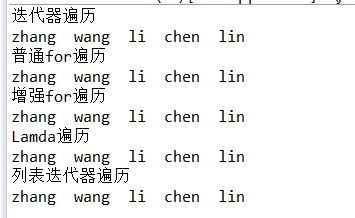List的遍历方式
迭代器遍历,普通for遍历,增强for遍历,Lamda遍历,列表迭代器遍历
演示代码如下
public class Main { public static void main(String a[]) { List<String> list = new ArrayList<>(); list.add("zhang"); list.add("wang"); list.add("li"); list.add("chen"); list.add("lin"); //1.迭代器遍历,需要用到Iterator System.out.println("迭代器遍历"); Iterator<String> it = list.iterator(); while (it.hasNext()) { System.out.printf(it.next()+" "); } System.out.println(); //2. 普通for遍历,借用size()方法 System.out.println("普通for遍历"); for (int i = 0; i < list.size(); i++) { System.out.printf(list.get(i)+" "); } System.out.println(); //3.增强for,也就是foreach System.out.println("增强for遍历"); for (String string : list) { System.out.printf(string+" "); } System.out.println(); //4.lamda遍历,利用List的forEach System.out.println("Lamda遍历"); list.forEach(s->System.out.printf(s+" ")); System.out.println(); //5.列表迭代器 System.out.println("列表迭代器遍历"); ListIterator<String> lit = list.listIterator(); while(lit.hasNext()) { System.out.printf(lit.next()+" "); } } }
运行截图:

总结:
迭代器遍历:这种方法可以保证遍历的顺序,但每次迭代都会创建新的Iterator对象,这会影响性能。此外,使用Iterator时需要注意检查hasNext(),这可能会使代码显得不够简洁,甚至报错。

普通for遍历:这种方法需要知道元素的索引,这在某些情况下可能是必要的。然而,如果List很大,那么每次访问都需要进行索引计算,这会降低性能。此外,这种方法也无法保证遍历的顺序。
增强for遍历:这种方法最简单,可读性最好,但它的性能不是最优。因为每次迭代都会创建Iterator对象,而创建Iterator对象是有额外开销的。此外,这种方法不能保证遍历的顺序,因为List的元素可能被其他线程改变。
Lamda遍历:这种方法在Java 8之后引入,结合了for-each循环和索引,使遍历更高效。它没有创建额外的Iterator或ListIterator对象,因此性能较好。此外,使用这种方法时不需要检查遍历是否结束,因为它会在遍历结束后自动停止。

列表迭代器遍历:这种方法可以保证遍历的顺序,并且可以获取前一个和后一个元素。但是,它也有类似Iterator的问题,即每次迭代需要创建新的ListIterator对象。不过它可以在遍历时添加元素,这是迭代器不能实现的
